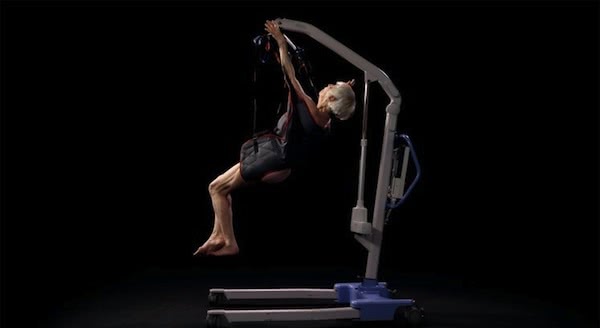Video installations are a difficult sell. While Hollywood has certainly stretched how long people are willing to sit in a dark room full of strangers, it hasn’t really translated to your typical art gallery patron. To wander a museum and find yourself midpoint through a video with no immediate context is a challenge. With her most recent work, Lift, running at 14 minutes, it’s a concern artist Kate Murphy is well aware of.
“It’s a gamble,” she admits. “Most people will stand in front of a painting for a few seconds before walking on, and that’s no different to video. It’s about capturing your viewer, and with my work I make it so there’s no real beginning, middle or end. The viewer can enter the space at any point and get something from it. I do love the idea that the viewer can, in a gallery setting, engage with the work for as long as they want and then have the ability to return on a different day to engage some more. It really appeals to me, as does the multiple screen form, which a lot of my work takes on and is something I wouldn’t be able to do in a cinema.”
The big challenge isn’t simply sustaining an audience’s interest. The practicalities of visiting an art gallery mean that often people simply don’t have enough time to endure a complete video. “It’s an ongoing frustration. As an artist I’ll always sit there and watch as long as I’m getting something out of it,” says Murphy. “My latest survey show features six works, which is over an hour viewing. You know, a person probably won’t go into a museum with an hour up there sleeve to sit and watch them all. Most people are in and out, trying to get around the gallery and see all the different works. With Lift, even if you were just there watching it for thirty seconds, I hope that the viewer will get what my motives are.”
It’s difficult to imagine visitors not being struck by Lift. An elderly naked woman sits suspended by a great mechanical arm while singing a simple song of sunshine and brightness. It’s at once gentle and dispassionate, something grimly reassuring. The genesis of the piece came from Murphy’s experiences with nursing homes. In watching these sufferers of dementia – witnessing the decline of mobility and the tragic loss of identity – Murphy became fascinated by the element of performance that began to surface.
“I was really interested in the performance of the everyday in a nursing home,” she says, “I was looking at anybody there with these uncontrollable movements, and knowing that they were someone –that they [had] had a career. With dementia they often go back to a time when they were in their prime, often around the ’50s, romancing and courting, and that often involved dance or song. So I thought, what if the woman was once a dancer? I wanted to capture that repetitive movement and the machine dictating her choreography in a way. It’s like the machine is her dance partner, something she’s completely dependent on.”
Though there are of course few silver linings to be found for those living with dementia, Murphy does raise a compelling point you feel is close to the heart of Lift. “The song [from Lift] is actually from a woman I met in a nursing home in a very demented state, and she just sings. It’s really beautiful in a way. As family of those who suffer from dementia we say it can be kind, and for this woman, she’d gone to a place of song. She just sings all day and this is one of the songs. Brighten up your day / let the sunshine in. I was struck by that.”
BY ADAM NORRIS
Liftby Kate Murphy presents at Breenspace from November 29 through December 21.

































